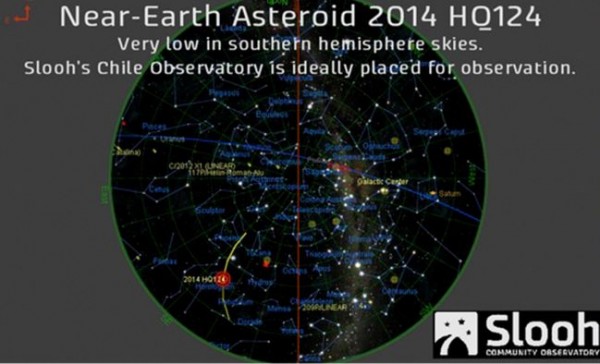Massive Earth-Killer Asteroid will Just Miss the Earth
| Arthur Dominic Villasanta | | Jun 06, 2014 06:48 AM EDT |
A sky map from Slooh shows the path of Near Earth-Asteroid 2014 HQ124, or The Beast
Forget Apophis. A gigantic asteroid aptly named "The Beast" is scaring the astronomers tracking its near-Earth course.
The size of a Nimitz-class nuclear aircraft carrier, The Beast is estimated at over 1,000 feet wide and could generate an explosive force measured in megatons were it to strike the Earth. Scientists say it will only take a 100-foot wide object to do great destruction to the planet.
Like Us on Facebook
Thankfully, the Beast will not hit the Earth but will pass disconcertingly close to the planet at less than a million miles on June 8. In scientific terms, that distance is equivalent to 3.2 lunar distances or about 716,500 miles.
What is worrying astronomers is that The Beast, or Asteroid 2014 HQ124, its scientific name, was only detected on April 23 before its nearest approach to the Earth despite space surveillance systems scanning outer space for asteroids and other threats.
Astronomers have discovered some 90 percent of the potentially dangerous asteroids that are 1,000 feet wide or larger. On the other hand, they have detected only 30 percent of objects that are some 460 feet wide but just one percent of the objects the size of The Beast.
HQ214 is some 10 to 20 times bigger than the asteroid that injured a thousand people last year when it exploded in the air above Chelyabinsk in Siberia.
The Beast was discovered by the NASA Wide-Field Infrared Survey Explorer. It is tearing through space at 31,000 miles per hour or 50,400 kilometers per hour. The Beast has been classified as a "Potentially Hazardous Asteroid."
"If it were to impact us, the energy released would be measured not in kilotons like the atomic bombs that ended World War II, but in H-bomb type megatons," said Bob Berman, an astronomer with Internet astronomy outreach venture Slooh.
Slooh is a robotic telescope service that can be viewed live through a web browser with a Flash plug-in.
©2015 Chinatopix All rights reserved. Do not reproduce without permission
EDITOR'S PICKS
-

Did the Trump administration just announce plans for a trade war with ‘hostile’ China and Russia?
-

US Senate passes Taiwan travel bill slammed by China
-

As Yan Sihong’s family grieves, here are other Chinese students who went missing abroad. Some have never been found
-

Beijing blasts Western critics who ‘smear China’ with the term sharp power
-

China Envoy Seeks to Defuse Tensions With U.S. as a Trade War Brews
-

Singapore's Deputy PM Provides Bitcoin Vote of Confidence Amid China's Blanket Bans
-

China warns investors over risks in overseas virtual currency trading
-

Chinese government most trustworthy: survey
-

Kashima Antlers On Course For Back-To-Back Titles
MOST POPULAR
LATEST NEWS
Zhou Yongkang: China's Former Security Chief Sentenced to Life in Prison

China's former Chief of the Ministry of Public Security, Zhou Yongkang, has been given a life sentence after he was found guilty of abusing his office, bribery and deliberately ... Full Article
TRENDING STORY

China Pork Prices Expected to Stabilize As The Supplies Recover

Elephone P9000 Smartphone is now on Sale on Amazon India

There's a Big Chance Cliffhangers Won't Still Be Resolved When Grey's Anatomy Season 13 Returns

Supreme Court Ruled on Samsung vs Apple Dispute for Patent Infringement

Microsoft Surface Pro 5 Rumors and Release Date: What is the Latest?










